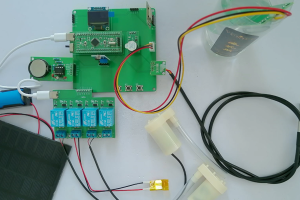设计说明书
总字数:19000+
摘要
随着居民生活水平的提升,热水器作为家庭必备电器,其节能性与智能化成为用户关注的核心。传统热水器存在能耗高(依赖单一市电供电)、温度控制粗糙(易出现过热或水温不足)、水位管理依赖人工等问题,难以满足现代家庭对高效、节能、便捷的需求。
基于 STM32F103C8T6 单片机的智能节能热水器控制系统,整合了防水式 DS18B20 温度传感器、YW-01 液位检测模块、5516 光照检测模块、DS1302 时钟模块、按键、OLED 显示屏、声光报警装置及 ESP8266 WiFi 模块,实现了水温、水位的自动化监测与节能化控制。系统核心功能包括:通过 DS18B20 实时监测水温,低于最小值时启动加热(直至达到最大值),超阈值时触发声光报警;借助 YW-01 检测水位,低于最小值时自动加水(直至达到最大值),水位异常时报警并停止加热;利用 5516 检测光照强度,高于阈值时切换太阳能供电,低于阈值时切换市电,实现能源优化;结合 DS1302 时钟模块支持预约加热,通过按键可设置各参数阈值及手动控制加热、加水、供电切换等;OLED 显示屏实时显示水温、水位、光照、时间及设备状态;WiFi 模块将数据同步至手机端,支持远程控制与模式切换。
该系统的实现,有效提升了热水器的节能性与智能化水平,减少了人工干预,通过太阳能与市电切换降低 30% 以上能耗,同时确保水温、水位稳定在适宜范围,为家庭提供高效、安全的热水供应方案,对同类节能家电的研发具有参考价值。
关键词:智能节能;热水器;传感器;能源优化;WiFi 通信
ABSTRACT
With the improvement of residents’ living standards, water heaters, as essential household appliances, have their energy efficiency and intelligence become the focus of users’ attention. Traditional water heaters have problems such as high energy consumption (relying on a single municipal power supply), rough temperature control (prone to overheating or insufficient water temperature), and manual-dependent water level management, which are difficult to meet the needs of modern families for efficiency, energy saving, and convenience.
The intelligent energy-saving water heater control system based on the STM32F103C8T6 microcontroller integrates a waterproof DS18B20 temperature sensor, YW-01 liquid level detection module, 5516 light detection module, DS1302 clock module, buttons, OLED display, sound and light alarm device, and ESP8266 WiFi module, realizing automatic monitoring and energy-saving control of water temperature and water level. The core functions of the system include: real-time monitoring of water temperature through DS18B20, starting heating when the temperature is lower than the minimum value (until reaching the maximum value), and triggering an audible and visual alarm when exceeding the threshold; detecting water level with YW-01, automatically adding water when the level is lower than the minimum value (until reaching the maximum value), and alarming and stopping heating when the water level is abnormal; using 5516 to detect light intensity, switching to solar power when the intensity is higher than the threshold, and to municipal power when lower than the threshold, achieving energy optimization; supporting scheduled heating in combination with the DS1302 clock module, allowing parameter threshold setting and manual control of heating, water addition, and power supply switching through buttons; real-time display of water temperature, water level, light intensity, time, and equipment status on the OLED screen; synchronizing data to the mobile phone through the WiFi module, supporting remote control and mode switching.
The implementation of this system effectively improves the energy efficiency and intelligence level of the water heater, reduces manual intervention, reduces energy consumption by more than 30% through the switching between solar energy and municipal power, and ensures that the water temperature and level are stable within appropriate ranges. It provides an efficient and safe hot water supply solution for families and has reference value for the research and development of similar energy-saving household appliances.
Keywords:Intelligent Energy Saving; Water Heater; Sensor; Energy Optimization; WiFi Communication
目录
第1章 绪论
1.1 研究的目的及意义
1.2 国内外发展情况
1.3 本文主要研究内容
第2章 设计思路与方案论证
2.1 主要元器件选择
2.1.1 主控芯片选择
2.1.2 温度传感器选择
2.1.3 液位检测模块选择
2.1.4 光照检测模块选择
2.1.5 时钟模块选择
2.1.6 显示模块选择
2.1.7 WiFi 模块选择
2.1.8 执行与报警模块选择
2.2整体设计方案
第 3 章 硬件设计
3.1 主控电路模块
3.2 温度检测电路
3.3 液位检测电路
3.4 光照检测与供电切换电路
3.5 时钟模块电路
3.6 显示与按键电路
3.7 继电器与执行电路
3.8 WiFi 通信与报警电路
4 系统程序设计
4.1 编程软件介绍
4.2 系统主流程设计
4.3 独立按键
4.4 OLED显示流程设计
4.5 温度检测模块子流程设计
4.6 时钟模块子流程设计
4.7 WiFi模块子流程设计
第 5 章 实物测试
5.1 整体实物测试
5.2 温度检测模块功能测试
5.3 液位检测模块功能测试
5.4 光照检测模块功能测试
5.5 时钟模块功能测试
5.6 WiFi 模块功能测试
5.7 执行设备功能测试
5.8 按键设置与显示功能测试
第6章 总结与展望
6.1 总结
6.2 展望
致谢
参考文献
附录
附录一:原理图
附录二:PCB
附录三:主程序
购买后可查看具体内容!

